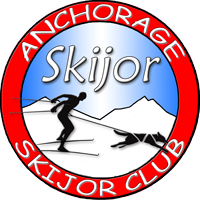Harness
The harness transfers from the dog to the bungee. The most common kind of leash is the the traditional x-back harness which works well for most dogs. The x-back design is also the most readily available.
Many users prefer the distance harnesses for skijoring. These harnesses also work well for canicross and for bikejoring.
Several companies sell harnesses specifically designed for skijoring:
- SkijorNow Fastback Harness
- Free Motion Harness by Non-Stop
Skijor Line
The skijor line connects the dog or dogs to the driver. It usually consists of a bungee and one or more tug lines. The elastic material inside the bungee prevents sudden shock to the dog's skeleton and helps control slack. The IFSS Race Rules stipulate that the extended lead be 2.5 to 3.5 meters (8.2 to 11.5 feet). For fear that a hard metal object attached to the driver's end of a loose bungee could hurt other dogs or people, then IFSS forbids metal on the driver's end. Two or more dogs may run in single file or side-by-side. Most dogs, though, are easiest to control if they are side-by-side.
TheAnchorage Skijor Club makes and sells skijor lines.
Quick Release
In case of emergency (e.g., moose attack), or in a race situation where dogs need to be quickly and easily untangled, untethering the dog(s) can be important. For races, the IFSS requires either a hook or a quick release device.
The down side of hooks or quick releases is that the dog may get loose accidentally, for instance, with a fall. An excited dog or two can then get into a lot of mischief or even become injured. One may spend a long time looking for a loose dog.
An alternative to a quick release system is a large carabiner which can used to relatively quickly release the dog(s).
Skijor Belt
The belt connects the driver to the leash. For racing the IFSS requires the belt be at least 7cm wide across the back. The most important aspect of a skijor belt is that the pulling force from the dog is centered on the driver's center of gravity. In most humans, this is in the midline at the level of the symphysis pubis. If the force is centered too high, then the dog will cause the driver to fall forward. If the force is too low, then the driver will fall backward. Because any belt will tend to move above the iliac crests, the belt must have leg bands that loop through the crotch in order to prevent the belt from migrating. To put it another way, don't purchase a skijor belt without crotch straps.
Padding on a skijor belt is unnecessary:
- the force on the belt is intermittent and the force while the dog is pulling is only 3-pounds.
- the force is spread out over a very wide, padded area of the driver's body
- the padding just makes the belt harder to pack and store.
Another option is a mountaineering harness rather than a dedicated skijoring belt:
- mountaineering harnesses are much stronger than skijor harnesses.
- mountaineering harnesses are cheaper
- if one buys a mountaineering harness, you can use it for mountaineering.
I use the Black Diamond Alpine Bod Climbing Harness.
Skis and Boots
On skijoring trails, we almost always use skate skis. We recommend one goes to a reputable ski shop to purchase skis so the skis can be properly fitted, the bindings can be properly mounted and the skis can be serviced as needed. Likewise, boots need to be fitted, so boots can't be ordered from a catalogue. Ski shops in Anchorage:
Used equipment can be bought at Play It Again Sports. Also, the Nordic Ski Association of Anchorage will has a yearly ski swap..
It's best to use shorter "rock skis" early in the year because the trails are narrower and rocks and sticks cut the base.
Skis with sharp points or with metal edges are not allowed in races.
Ski Poles
The poles used for skijoring are generally about 10cm longer than those used for skate skiing. The length should be to one's nose for skijoring and up to one's chin for skate skiing. Beginners should choose cheap metal poles. More experienced skiers may choose poles with detatchable wrist loops.
Initially, one has to remove his poles in order to manage the rest of one's equipment and the dogs. With more experience one learns to do most tasks while wearing thick gloves and ski poles.
Dog Booties
Neckline
